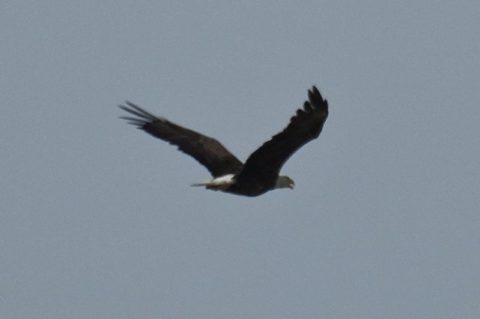See no Eagle, Hear no Eagle, Speak no Eagle.
Today we have a lesson in target fixation, namely why it’s important to continue to be aware of your surroundings while your out shooting. Friday I went down to Everglades national park again for the express purpose of trying to get a picture of a Bald Eagle. My thinking being that the USGS bird sheet for Everglades National Park shows them as being common year round (50% of the time there’s a sighting) coupled with their recent removal from the Endangered Species list, meaning there should be more of them, that it should be possible to find a spot somewhere between a nesting site and the ocean where I assume they are fishing, and sit tight and wait for one to fly by.
Well the morning was blown searching for possible nesting sites, hey Eagle nests are huge and hard to miss. But alas none were visible from any of the easily accessible areas (i.e. off the park road or any of the boardwalks or trails), and I wasn’t really in the mood to go hiking out across the endless sea of grass to find one either. So I settled for plan B, Osprey’s; and this is where the target fixation comes into play. While sitting on an Osprey waiting for it to take off–which it did some 6 hours later (yes I waited that long)–I was overflown by my eagle. And yes, I totally missed the approach and flyover because I was so busy waiting for the bird in the viewfinder to take off. Talk about shooting one’s self in the foot.

Comments
Frustrating. However you at least spotted one. Now time to go back and get a picture of an eagle that says “this is my eagle, there are many like it, but this is mine”.
I am happy you saw the Eagle and got something. But seriously, how could you scan the horizons for 6 hours *and* watch the osprey for movements? I guess if you had a motion capture on one camera and used another, but …
Practically not a whole lot happens a lot of the time, and animals tend to give pretty good indications of what they are thinking when you learn how to read them. I’m still not there yet, though.
In practice you can tell a few moments before the bird takes off that it’s probably going to do so. Which opens up a whole lot of time (especially when the subject in camera 1 is sitting still for 5 hours), to be looking around. Also it’s not like you can’t see a bird at quite some distance with clear skies. It’s also easier if the locked off camera has a cable release on it so you don’t have to touch it to work the shutter release.
The rest is patience, lots and lots of patience.